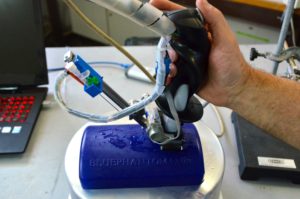
HANDS: A Robot That Can Insert Surgical Catheters
HANDS: A Robot That Can Insert Surgical Catheters
April 21, 2015
Newsweek — As sophisticated as modern medicine has become, the best method available to doctors to insert a catheter is still to use their own two hands, a needle and some wire.
Prof. Hugo Guterman, of BGU’s Department of Electrical and Computer Engineering and the founding director of the University’s Laboratory for Autonomous Robotics, wants to remove the first requirement.
His lab is currently developing the Human-Assisted Needle Delivery System, HANDS, a somewhat ironic “backronym” for a process that inserts surgical catheters robotically.
Doctors often use a catheter during heart surgeries, either to inject a dye into the heart to have a better look at what’s awry or to send radio-frequency energy to suspicious tissue, so they can destroy it and restore a normal heartbeat.
Missing a vein during blood draws is an annoying problem, but missing these major vessels, either through the groin, arm or throat, en route to the chambers of a patient’s heart can be catastrophic.
HANDS has the ability to pinpoint blood vessels from as shallow as half a centimeter to as deep as 30 centimeters.
“Any place that we can enter in the body, we think we will be able to enter much faster and with more accuracy,” says Prof. Guterman.
HANDS is patented and currently in clinical trials. It hasn’t yet received U.S. Food and Drug Administration approval, but already Prof. Guterman’s lab has visions of applying the technology to improving the accuracy of biopsies, with a focus on breast cancer.
The BGU lab is also currently working with Cincinnati Children’s Hospital in testing to see if HANDS can help reduce nurse and doctor error when operating on children, who have smaller vessels that require more precise catheterization.
Ideally, says Guterman, HANDS will be fully autonomous. With only the press of a start button, the device will be able to locate the ideal site to enter a vein or collect samples of cancerous tissue and do it successfully the first time, every time.




